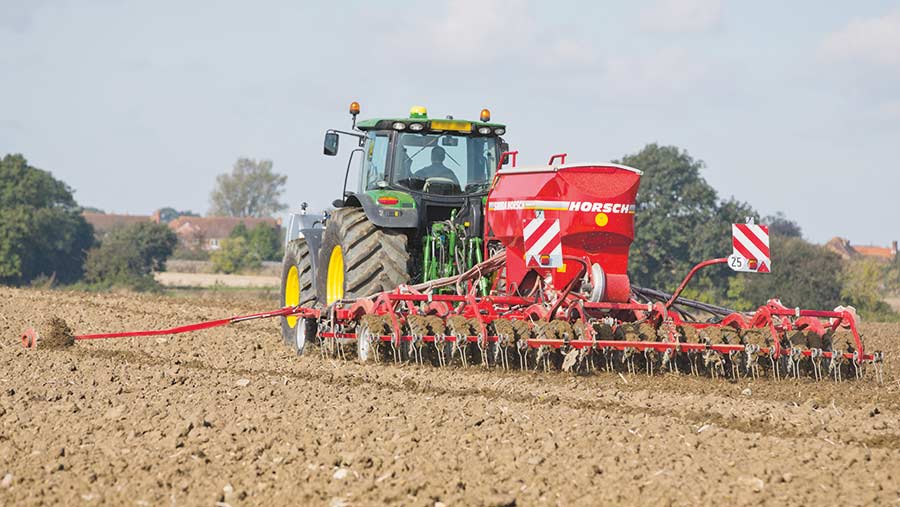Core principles of successful late drilling to beat blackgrass
 © Gary Naylor
© Gary Naylor Growers with blackgrass have been beaten over the head with the message that drilling winter wheat later in the autumn is essential for better in-crop control – and it looks like it is sinking in.
Crops has seen cropping data that suggests growers in England have drifted from the majority of wheat being sown in September to the majority now planted in October.
This tactic to outmanoeuvre blackgrass doesn’t come without its risks, however, and experts agree that sticking to some core principles to ensure late-drilled crops are in good order and blackgrass numbers are reduced.
Distribution and agronomy group Agrii has been running a blackgrass trial at its Stow Longa site, east of Huntingdon, for the past 16 years and its data to back up the blackgrass benefit of late drilling is telling.
See also: What to consider before using spuds to clean up blackgrass
One trial sequence was a four-year rotation that started on a third wheat and was followed by an oilseed rape and three further wheats. It was designed to make blackgrass control a tough job.
Colin Lloyd, Agrii’s agronomy manager, says a comparison was made between end-of-September and mid-October drilling across this rotation and the cost benefit for the October slot averaged £361/ha over the four years from better blackgrass control.
“That is not an insignificant margin. The problem for the grower, however, is that they drill late and still see blackgrass and wonder why they bothered – but if you drill earlier you would have even more, so it is all relative,” explains Mr Lloyd.
“You won’t get rid of it with late drilling alone, but in a numbers game it gives you an big advantage.”
Early bird
There is a plethora of cultivation and establishment systems out there, but no matter which system is used, growers should aim to get ground cultivated as quickly as possible behind the combine.

Colin Lloyd
Following this, Mr Lloyd says, it is then crucial to leave the ground well alone until the drill comes back in, allowing for some natural weathering, with the drill set up to disturb as little soil as possible.
“The problem is there is always a temptation to go back in and give it a little tickle and another tickle, but you will just encourage more blackgrass.
“If you get in there early enough, you should leave it, spray it off once and drill,” he explains.
This is possible with the right soil structure, but there may be drainage or structural issues, so getting out with the spade and digging some holes is crucial to identify problems and take remedial action.
“It’s getting back to basics. You must identify any drains or ditches that need clearing or whether you need to get the mole plough in there. This stuff makes a hell of a difference, as we learned in 2012,” says Mr Lloyd.
Yield swing
The difference that structure can make to the chances of late-drilling success is again highlighted by data from Stow Longa, taken from the 2013-14 season.
Two crops were compared. One was drilled at the end of October and the other could not be drilled until mid-November.
The other difference was that the late-October crop followed a number of seasons using a range of cultivation methods, whereas the later-drilled crop followed three seasons of minimum or strip tillage.
Mr Lloyd explains that the October slot yielded 12.77t/ha, but the later-drilled area just 4.6t/ha – and he says the most influential factor was the state of the soil.
“Despite the seed return being relatively low, the November slot went into soils that were heavy, wet and had no structure, so establishment was poor, roots didn’t go down and the crop was uncompetitive.
“In October, we still managed to get a chit to get a lot of blackgrass out the way and the structure was much better, with the right conditions to drill late, and we got an 8t/ha swing.
“You can drill late, but if the conditions aren’t right underneath it isn’t going to work,” he says.
Traffic light
Ahead of the autumn drilling period, growers should label fields on a traffic light system of green, amber and red – based on the blackgrass risk – and plan a drilling sequence that leaves the worst until last, advises Mr Lloyd.
Core principles for successful late drilling
- Carry out structural remedial work and primary cultivations early
- Leave the ground alone until drilling
- Apply one hit of glyphosate with the correct nozzle and forward speed
- Drill with as little disturbance as possible
- Spray residual herbicide with the correct nozzle and forward speed
He also emphasises that variety choice can also play a role in successful establishment and blackgrass control when pushing drilling date into mid/late October and beyond.
One example is Group 1 winter wheat Skyfall, which has the characteristics to be drilled in October right through until February before risking any problems with vernalisation. Flexible spring wheat varieties such as Mulika are also worth considering.
As long as the ground is set up and ready to go, if conditions go against late-autumn drilling growers can then use the option of leaving it until the spring and drill once the ground dries.
“If you buy the right variety, it will allow you to do that, but you could also think about rotational changes [to more spring crops], which can ease your autumn workload,” says Mr Lloyd.
Smaller stacks
The final piece of the puzzle is the residual herbicide strategy when drilling later. Assuming there should be less blackgrass in the crop, the chemistry should have less work to do.
In addition, there should be more moisture, enabling key pre-emergence actives such as flufenacet to work much more effectively at a later timing.
As a result, Mr Lloyd says the need to “stack” so many herbicides at a high cost should be reviewed, although much will depend on the overall blackgrass pressure within a particular field.
“If the pressure is enormous, then perhaps you don’t want to shave down your stacks quite so quickly, but there is certainly room for manoeuvre.”
Case study: Peter Cartwright, Revesby Estate, Lincolnshire

Peter Cartwright
An overhaul of crop establishment method to include later drilling has allowed one Lincolnshire estate to rein-in its blackgrass populations to more manageable levels.
A key part of that strategy has been to assess each field on its merits ahead of the autumn. Where blackgrass risk is high, drilling is left until mid to late October onwards to maximise pre-drilling control.
Farm manager Peter Cartwright explains that parts of the Revesby Estate farm were starting to become unable to support a sustainable winter wheat rotation due to high blackgrass levels.
A shift from a plough-based system that turned the ground over one year in three to a min-till system using a Horsch Terrano NT cultivator was the first significant change.
“The Terrano can work at very shallow depths, or as deep as you like, and we go in with that straight after the combine and leave it to weather naturally. We don’t touch it again until drilling to avoid another flush of blackgrass,” says Mr Cartwright.
Right time
He adds that this is a key part of being able to drill at the right time later in the autumn. “The soils need to be sitting right to take the weather and carry the drill when you need to.”
After an application of glyphosate, cleaner fields are drilled first in early October, but anything medium to high risk will not see the drill until at least 15 October, with the worst left until last.
A 6m Vaderstad Rapid Combi drill was changed for an 8m RapidC version to increase capacity. The machine can get around the estate in 10 days and, when required, Mr Cartwright’s three-man team can run the machine around the clock to ease pressure in a tight drilling window.
“We choose competitive varieties suitable to late drilling and the drill also allows us to drop phosphate and kieserite in to improve rooting and early tillering, which makes the crop compete with the blackgrass better, thanks to better rooting and more vigour.
“We also lift the front discs out of work so we are disturbing as little soil as possible, with just the discs behind the wheels working to take the wheelings out. This is a crucial part of discouraging blackgrass seed germination,” says Mr Cartwright.
Pre-emergence herbicide stacks remain high, with the worst fields getting a spray including Movon with a diflufenican top-up, plus 3 litres/ha of Defy, applied using forward and back nozzles in 300 litres of water, travelling no faster than 10kph.
Liberator then tops up the flufenacet and diflufenican in a follow-up application.
“If there isn’t rain, we wait for moisture to apply the pre-em. Anything longer than a week after drilling, glyphosate is added into the pre-em to take out any chitted blackgrass,” he explains.
Dry weather drill
One drawback of the Vaderstad is its ability to cope with wetter ground, so last year he invested in a Simba Horsch co6 direct drill for spring bean establishment – a quick change of tines and it can be a useful safety net for late wheat drilling when the going gets tough.
Moving into winter, the end of November is typically the cut-off for wheat drilling and he refuses to “maul in” any crops, preferring instead to switch to a spring crop.
Revesby Estate farm facts
- 1,200ha sandy clay, medium clay and heavy clay loams
- 1,000ha arable cropping
- 500ha winter wheat
- 250ha oilseed rape
- 100ha sugar beet
- 150ha divided between spring oats and spring beans
- 200ha in environmental schemes and grassland
“It all depends on the season and how open it is, but we won’t force it, as this will lead to an uncompetitive crop unable to compete against the weed, so we are better waiting until the spring,” he adds.
The direct drilling route is something that Mr Cartwright will go down in the short term. He has demoed a Horsch Avatar John Deere 750A and moving to a controlled traffic farming (CTF) system will avoid any compaction issues when it is introduced.
The plough will stay, however, as he believes you need flexibility in an establishment system to cope with whatever the weather throws at you.
“My view is that we will always have blackgrass, but it needs to be manageable. When it starts to rob yield, you need to plough and put spring crops in for three years,” he adds.
Looking ahead, he is going to stick to 15 October as his drill date. Assessing blackgrass levels on a scale of one to 10, with 10 being the worst, the dirtiest fields were an 8 in 2011. Mr Cartwright now puts them at two.
“Important parts of that have been later drilling and getting the pre-emergence herbicides applied right,” he adds.
Drill flexibility lengthens drilling window

Philip Wright
Machinery and soils expert Philip Wright says flexibility is the most important factor in gearing up your drilling operation for late-autumn sowing.
He says the best use of delayed drilling is for a spring crop, with ground in the spring tending to be drying out from the top down, whereas in the autumn it is usually getting wetter.
Despite that, growers will still want to drill a proportion of their wheat in the autumn to maximise yield, and to do so the farm’s drilling kit needs to be able to cope with all conditions, including wetter soil that is more vulnerable to damage.
“It is easy to say, but it is very difficult to achieve with one machine. In wetter conditions, weight is the biggest limiting factor and you don’t want a heavy drill.
“If you were starting from scratch [with your machinery], I certainly wouldn’t clear the shed out – have a look around to see what you have. It would be a good idea to keep a drill that’s light and able to cope with wetter soils,” says Mr Wright.
In the current economic climate, not every grower will be able to invest in a new drill that provides that flexibility, so exploring the possibility of losing weight from the existing drill could help.
“It is about tinkering and fine tuning to suit conditions. When it’s wet and you have a heavy drill with heavy rollers that’s the first thing that stops you.
“Can you the reduce weight? If it is possible to adjust the machine, do it. Some of these drills have big hoppers now and you could lose a tonne or two there,” says Mr Wright.
He adds that tractors should also be ballasted correctly, with minimum weight and tyres running at the lowest pressure possible, while tracked machines can also have weight removed, where appropriate, while maintaining even pressure across the tracks.
Minimal disturbance
Further adjustments may be required to minimise disturbance. The popular Vaderstad Rapid is a good example of a machine that can be changed to suit the objectives of delayed drilling.
Two rows of discs at the front can be taken out of work ahead of the disc coulters to ensure as little blackgrass as possible is encouraged to chit at drilling.
“Find out if low-disturbance kits or point options are available. With some tine-based drills, such as the Dale or Seed-Hawk, you can get coulter points with a different pitch angle, or alternative geometries to boil less soil,” says Mr Wright.
While adjustments can help, they can also be exhausted and if growers reach a dead end and cannot make their drill work in a later slot, it might be time to change to a different system.
Again, Mr Wright says this needs careful consideration to ensure that the investment is in a drill that will be able to cope with a wide range of conditions.
“You need to invest in a drill that builds in flexibility and is capable of whatever the future may bring. Traditionally, those that have a heavier disc-based drill will have a lighter tine drill at the back of the shed.”

